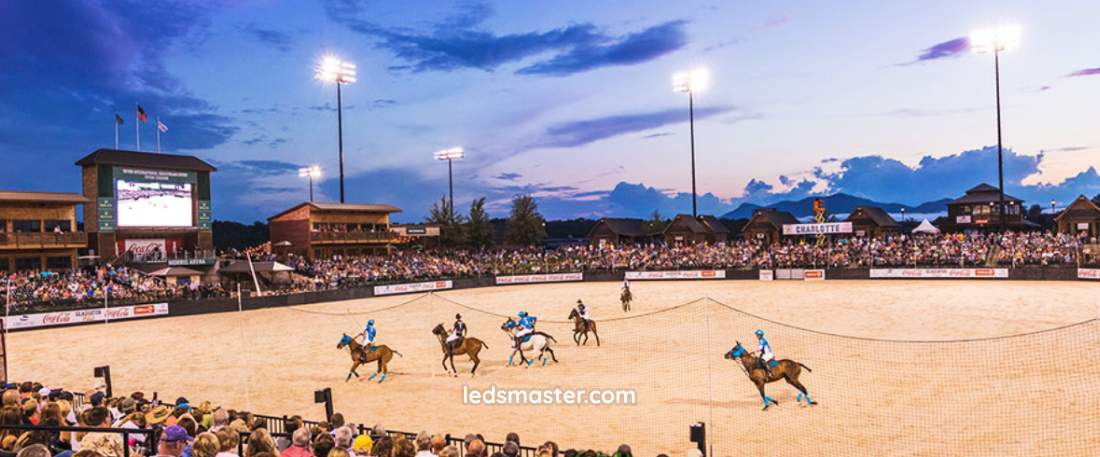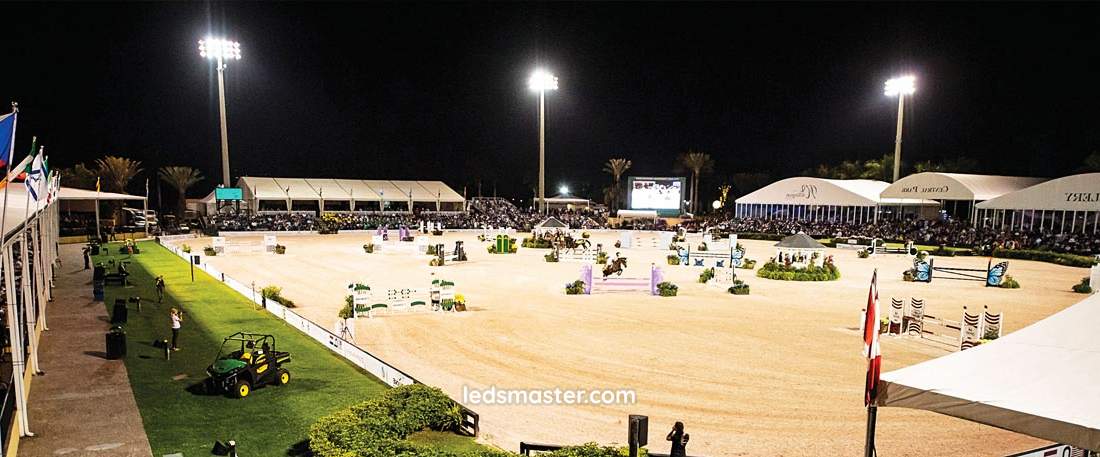Outdated or inefficient lighting not only hampers visibility but also affects safety and performance. Upgrading to a modern lighting system isn’t just about brightness; it’s about creating a well-lit environment where both horse and rider can shine. Discover how to revamp your arena with the perfect lighting replacement and elevate every moment spent under the stars.
Get your complimentary lighting design today
Ensuring adequate lighting is necessary for both horse and rider safety, providing visibility during evening or early morning hours, and enhancing the overall experience of using the arena. Over time, lighting systems may become outdated or inefficient, requiring replacement to meet modern needs.
Table of Contents
ToggleEvaluation includes understanding whether the existing lighting provides sufficient brightness, coverage, and uniformity across the arena. Over time, bulbs may lose their intensity, or fixtures may fail to distribute light evenly, leading to dark spots or glare. Observing how well the lighting performs in various conditions, such as during twilight or rainy weather, provides valuable insight into its effectiveness. Additionally, considering how the current system impacts rider and horse comfort will guide the selection of new lighting.

Another aspect of assessing the current lighting system is identifying any underlying issues that may necessitate replacement. These issues can include recurring maintenance problems, such as frequent bulb replacements, flickering lights, or increased energy consumption. If the system is outdated, it may no longer meet the energy efficiency standards of modern lighting solutions, resulting in higher operational costs. Furthermore, environmental factors, such as exposure to wind, rain, or dust, may have taken a toll on the fixtures or wiring, reducing their lifespan. Identifying such problems early on helps prevent further deterioration and ensures a smoother transition to a more effective lighting system.
Arenas that host competitive events or regular evening training sessions demand higher lighting standards than those used sporadically for recreational purposes. If the current lighting system struggles to meet the demands of regular nighttime use, it may be time for an upgrade. Additionally, the type of riding activity—whether it involves jumping, dressage, or general exercise—can influence the type of lighting needed, as certain activities require more focused or even illumination across the space.
When selecting lighting for an outdoor horse arena, several options are available, each with its own advantages and characteristics. Traditional halogen or metal halide lights have been commonly used in outdoor arenas for many years, but newer technologies, such as LED lighting, offer numerous benefits in terms of energy efficiency and longevity. LED lights have become the preferred choice for arena lighting replacements due to their lower energy consumption, reduced heat emission, and longer lifespan. These lights provide better illumination while consuming less power, making them an effective replacement option.
In addition to energy efficiency, LED lights provide a more focused beam of light, which helps reduce light pollution and glare. This is particularly useful for outdoor horse arenas located near residential areas, where excessive lighting could be a disturbance. Metal halide lights, while still effective, often produce more heat and consume more energy, which can lead to higher operating costs in the long run.
The color temperature of the lights affects how natural the lighting feels, which can impact both riders and horses. Cooler color temperatures, such as daylight white (5000K–6000K), are often preferred for outdoor arenas because they provide a crisp, bright environment that mimics natural daylight. This enhances visibility and allows for better contrast, which is essential for both performance and safety.
Brightness levels, measured in lumens, should be sufficient to light the arena without creating dark spots or overly bright areas. The goal is to achieve an even distribution of light, ensuring visibility across the entire space. Depending on the size of the arena, higher lumen outputs may be needed to ensure adequate lighting coverage. Installing lights that provide adjustable brightness levels or dimming capabilities can offer flexibility in managing the arena’s lighting based on specific needs or weather conditions.
Outdoor horse arena lighting must withstand the elements, including rain, wind, dust, and fluctuating temperatures. Therefore, it is essential to select lighting fixtures designed for outdoor use that offer durability and weather resistance. High-quality fixtures made from corrosion-resistant materials, such as aluminum or stainless steel, will last longer and require less maintenance. Additionally, lights with a high IP (Ingress Protection) rating are designed to resist dust and water, making them suitable for outdoor environments.
Choosing lighting with protective features, such as shatterproof lenses and sealed housings, will further increase the longevity of the system. Horse arenas often experience dust, dirt, and occasional impacts from wildlife or equipment, so durable lighting that can handle these factors without malfunctioning is ideal. Ensuring the lights are installed with proper shielding or enclosures can also reduce the chances of damage from environmental exposure.
LED lighting stands out as one of the most energy-efficient options available, consuming less power than traditional halogen or metal halide systems while providing superior brightness and light quality. This reduced energy consumption translates into lower utility bills, which can result in significant cost savings over time.
Energy-efficient lighting systems also produce less heat, which not only helps lower the ambient temperature in the arena but also extends the lifespan of the fixtures. Many LED systems come with dimming capabilities or sensors that allow the lights to adjust based on natural light levels, further optimizing energy use. Replacing outdated systems with energy-efficient alternatives reduces the environmental impact and contributes to sustainable energy practices.

Designing an appropriate lighting layout for an outdoor horse arena requires careful planning to ensure even distribution of light across the entire surface. The placement of light poles, the height of the fixtures, and the angle of illumination all play a role in achieving this goal. Lights should be positioned at the correct height to minimize glare and shadows, which can interfere with visibility for both riders and horses. Typically, light poles are installed around the perimeter of the arena, with the fixtures angled to direct the light towards the center.
When designing the layout, the size and shape of the arena must be considered, as well as any potential obstacles that could block the light, such as trees or surrounding structures. Achieving the right balance between pole height and fixture angle ensures that the entire arena is uniformly lit, without creating areas that are too bright or too dark. Working with a lighting designer or professional can help optimize the layout to meet the specific needs of the arena.
Once the new lighting system has been selected, it’s time to consider the installation process. While some arena owners may consider handling the installation themselves, hiring a professional installer is often the best option, especially for larger arenas or more complex lighting systems. Professional installers have the expertise to ensure the lights are installed safely and correctly, taking into account factors such as electrical load, weather resistance, and proper fixture alignment.
DIY installations, while feasible for smaller projects, may not provide the same level of precision or safety as a professional installation. Additionally, improper wiring or poorly installed fixtures can lead to maintenance issues, which can be costly to repair. Ensuring the system is installed according to local building codes and safety regulations is crucial for long-term reliability.
Regular inspections should be conducted to check for issues such as burned-out bulbs, damaged fixtures, or wiring problems. Keeping the fixtures clean is also important, as dust and debris can accumulate on the lenses, reducing the effectiveness of the lights. Using fixtures that are easy to access and clean will simplify the maintenance process.
LED lights generally require less maintenance than traditional lighting systems due to their long lifespan and durability. However, periodic checks are still necessary to ensure that the system continues to operate efficiently. In addition to cleaning the fixtures, it’s also useful to inspect the wiring and connections periodically, especially in areas prone to moisture or extreme weather conditions.
As technology continues to advance, smart lighting systems have become a popular choice for outdoor arenas. These systems allow for remote control of the lighting, providing flexibility in managing brightness levels and energy usage. With smart lighting, arena owners can easily adjust the lights according to specific needs, whether that’s dimming the lights during practice sessions or increasing brightness for competitions.
Smart systems often come with built-in sensors that detect natural light levels or motion, automatically adjusting the lighting based on environmental conditions. This helps reduce energy consumption by ensuring the lights are only used when needed. In the future, upgrading to smart lighting systems could further improve the functionality and efficiency of outdoor horse arena lighting.
Replacing outdated lighting systems with modern solutions, such as LED lighting, provides long-term benefits for outdoor horse arenas. These systems offer superior brightness, energy efficiency, and durability, reducing maintenance costs and extending the lifespan of the lighting. For arenas that host regular events or training sessions, modern lighting systems enhance the experience for riders, horses, and spectators alike by providing clear, consistent illumination.
Additionally, switching to energy-efficient lighting contributes to sustainability efforts by reducing energy consumption and lowering greenhouse gas emissions. Over time, the cost savings from reduced energy use and lower maintenance needs will offset the initial investment in the lighting replacement, making it a worthwhile improvement for any arena.
Replacing the lighting in an outdoor horse arena is an investment in safety, performance, and energy efficiency. By carefully evaluating the current system, selecting the right lighting for replacement, and ensuring proper installation and maintenance, arena owners can enhance visibility and overall functionality. Modern lighting solutions, such as LED technology, offer numerous benefits, including improved brightness, reduced energy consumption, and greater durability. As technology advances, exploring options such as smart lighting systems can further enhance the arena’s lighting capabilities, providing a better experience for both horses and riders while contributing to long-term cost savings and sustainability.